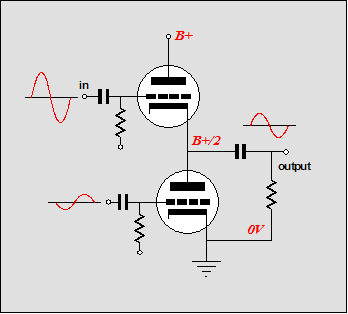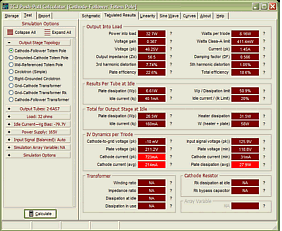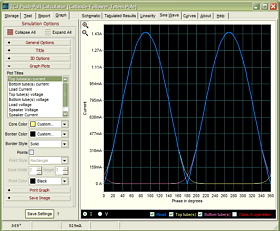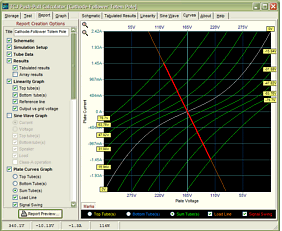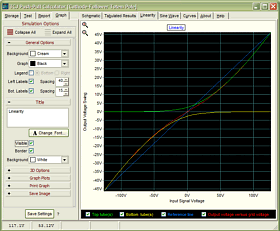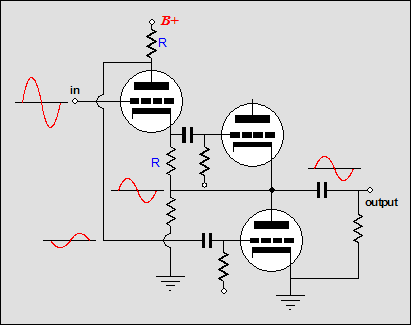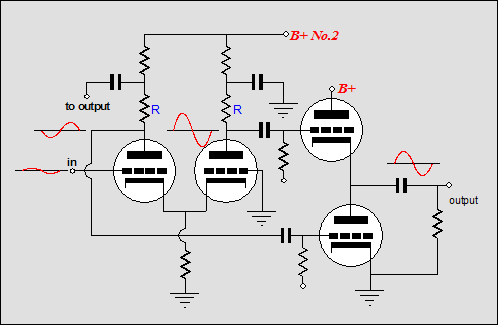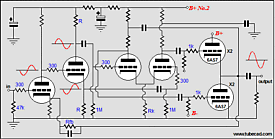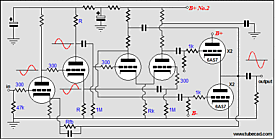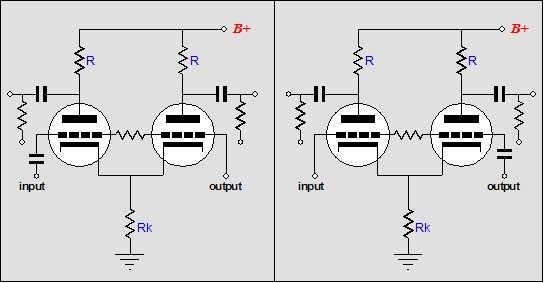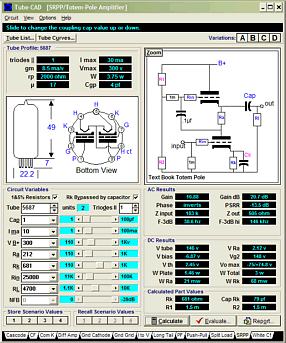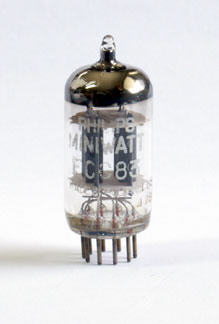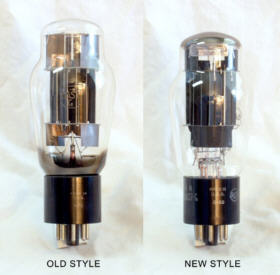| John Broskie's Guide to Tube Circuit Analysis & Design |
28 Nov 2004 OTL amplifier design (continued from 11/24) We keep working backwards. The output stage consists of a totem-pole arrangement, wherein both top and bottom triodes function as cathode followers. The power supply will be monopolar, rather than bipolar, as I want to use an output coupling capacitor (because the load is four times greater than usual, the capacitor’s value can be four times lower than usual; besides, it’s safer).
Because the cathode follower topology offers no voltage gain, the driver stage will have to provide all the voltage swing needed to drive the output tubes to full power. How much voltage swing is needed? Once again we cheat and use TCJ Push-Pull Calculator to find out.
The negative bias voltage is (rounding up) –80 volts. Since we do not plan on entering positive grid bias, is this then the right value? It was a good guess, but no. The bias voltage must be added to the peak output voltage at full output, which in this case is 46 volts, for a total of 126 volts of peak swing. This value is what will be presented to the top triodes, whereas the bottom triodes will see only the bias voltage (80 volts) as their peak input signal, as their cathodes are grounded. With this information, we can stipulate that the input and driver stages must provide at a combined gain of at least 130 and that the driver stage must be capable of swinging at least 130 volts of clean output. This not a trivial voltage swing, as it approaches what is needed to drive electrostatic headphones. Thus, because if its limited voltage swing, it is unlikely that we will be able to use a split-load phase splitter as the driver stage. The long-tail phase splitter, on the other hand, offers a larger potential voltage swing (under the same B+ voltages), although poorer a balance between outputs.
OTL à la Williamson amplifier The left schematic shows a Williamson-like amplifier with the output stage configured as cathode followers; the right schematic, as grounded-cathode amplifiers. Which is better? The answer depends on engineering, politics, and how gloomy our outlook is. The CF output stage and driver stage define a short sub-feedback loop within a lower-overall feedback loop. The GK output stage and driver stage find their feedback through the higher-overall feedback loop that encompasses the entire amplifier. This latter approach will produce the lowest distortion and output impedance, but at the cost of greater potential instability and possibly worse overload recovery. Politically, the GK output stage is considered crucial to the Transcendent-OTL crowd—who view any deviation from the hallowed patent as an unpardonable sin (imagine the twisted underwear resulting from the omission of the magic cathode follower stage that many believe can equalize drive signals for bottom and top triodes; I can easily imagine the angry e-mails that I will receive for having touched the third rail of tube-audio fanaticism). Pessimistically speaking (or is it "realistically speaking"), the more reactive parts and the higher the feedback ratio, the greater the chances are that the amplifier will become an oscillator. (No matter which path is taken, expect to do some tweaking and value swapping to get things right.) You can probably guess which path I would choose to follow. (If I were to build either of these amplifiers, I would use 5965s for all input and driver locations and I would "long tail" the differential amplifier by connecting the common cathode resistor to a well-filltered negative PS or break the differential aspect by giving each triode its own separate cathode resistor. I would also look into adding a DC-coupled cathode-follower stage to drive the 6AS7's grids directly.) Design philosophy If we limit the feedback loop’s span to the driver stage and output stage, we can allow the input stage’s distortion to pass freely; and as the input stage will be a simple single-ended ground-cathode amplifier, we can expect the 2nd harmonic distortion to prevail. The resulting spectrum of distortion harmonics might be expected to fall somewhere in between a single-ended and a push-pull amplifier. So how much feedback will be returned to the driver stage from the output? Because the tubes are so nonlinear in this application, 100% will be needed to iron out the 6AS7s. In other words, we will feed all of the output directly into the negative input of the long-tailed phase splitter, the other input receiving all of the input signal, making a unity-gain buffer out of the driver and output stage. 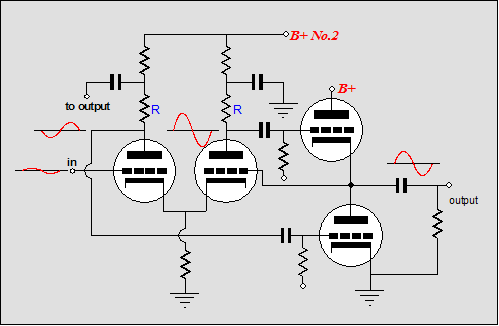
If the driver stage could summon infinite gain, the input stage would only have to deliver 45 volts of peak signal into the driver stage, with the output following along with 45 volts of swing. Unfortunately, the driver stage will most probably only have a maximum open-loop gain of 20, depending on the tubes chosen (under perfect conditions. the theoretical maximum is half of the mu of the triode used). Thus, the input stage will have to provide the 45 volts we expect to see at the output plus whatever signal voltage will be needed to drive the driver stage. Depending on the driver tube used, this drive voltage will probably fall between 48 to 55 volts, which means that the input stage must realize a gain of at least 48 to 55, assuming a 1-volt input signal to achieve full power output. Input and driver tubes So, we have our tube lineup: two 12AX7s and two 6AS7s per channel. Now, let’s fill in the details. Starting once again at the end, the driver stage consists of a long-tail phase splitter that accepts the input at one grid and the output signal at the other grid. Do we DC-couple these stages, capacitor-couple them, or some blend of both? While DC coupling is possible (particularly in SPICE, wherein perfect parts are freely available), it will be quite a design task to keep all these portions of the amplifier in DC stability. Using one coupling capacitor can make life much easier for us. We can place the coupling capacitor either before or after the long-tail phase splitter, as shown below.
In both cases the 1M resistor in between the triodes sets the DC bias point for the coupling capacitor. The advantage of placing the coupling capacitor in between the phase splitter and the output stage is that the coupling capacitor is now within the feedback loop; this is also the disadvantage to placing the capacitor there, where phase shifts can cause headaches. Thus, we opt for the coupling capacitor connecting the input to the phase splitter, as shown on the left. 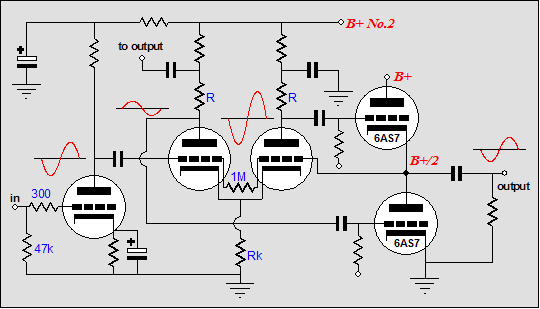
The amplifier circuit only lacks power supply voltages and part values. But before we commence, let’s pause and pull back from the schematic. The weak point is the phase splitter. Normally, the long-tail phase splitter receives an input signal at one grid, with the other grid grounded. In this configuration, the common cathode resistor plays a less important role than in our circuit, wherein the phase splitter receives two input signals. Imagine the situation in which the phase splitter uses two triodes that boast infinitely high amplification factors. In this case, both inputs would see the same large voltage swings that the output stage produced (+/- 45 volts). In this scenario, what would the common cathode connection see? It would remain fixed at some idle voltage, but rather it would perfectly trace the same output voltage swings (minus its own negative bias voltage). So? This means that the common cathode resistor does not deliver the ideal constant-current, but a signal-tracing changing current. The result is a reduction in gain that a constant-current source would work to save. 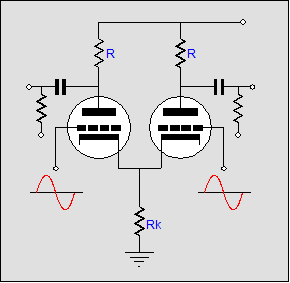
Constant-current sources 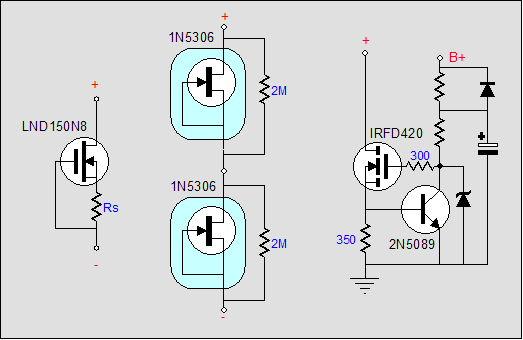
Each solution has its advantages, but I want to keep the amplifier pure tube. Making a pseudo constant-current source out of triodes is fairly easy. We just need to provide a large unbypassed cathode resistor, the total effective impedance will equal the triode’s rp plus the cathode resistor’s value against (mu + 1). For example, a 12AX7 with a 10k cathode resistor will present an effective impedance of 62k + (101 x 10k), which equals 1,072,000 ohms, which only requires about 200v versus the 2,144 volts that an equivalently-valued resistor would require at 2mA. Now we run into a new problem: the 12AX7 triode used to create a constant-current source will have to sink twice the current that each phase splitter triode draws and it will have much less voltage available within to it. The solution: we can either switch to another triode type or we can use a negative power supply rail. If you guessed that I was going to recommend the latter approach, you were wrong; well, at least half wrong, as I recommend both approaches. The 12BZ7 is very much like two 12AX7s wired in parallel. Using this tube in the grounded-cathode amplifier input stage will also help increase the high-frequency response into the phase splitter, as the doubled current will be twice as effective in burning through the Miller capacitance the phase splitter presents. (Besides, they’re cheap, as few know about them). Negative power supplies add an extra layer of complexity to our design that I would prefer to avoid, but as we’re going to need one anyway to bias the bottom 6AS7s, we might as well exploit it further. 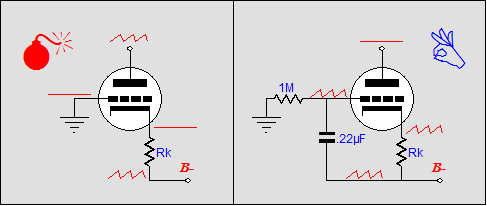 Above left is how not to wire a tube-based constant-current source. Can you spot the flaw? Why is the grid grounded? Will that lower or increase the noise the circuit passes? The answer is that the grid must be referenced to where the common-cathode resistor terminates. Moving the grid’s connection to the negative power supply rail ensures that the cathode resistor sees a (closer approximation to) constant voltage different, which in turn ensures that it conducts a (closer approximation to) constant current. 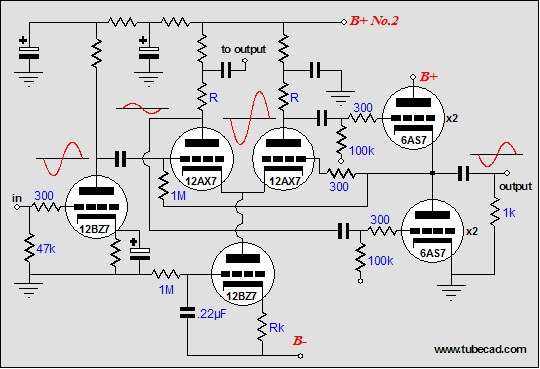
Now that we have our topology and tube types in place, we can move on to the part values, but not today. Next time: the part values and then the power supply deign. //JRB |
Tube CAD does the hard math for you. This program covers 13 types of tube circuits, each one divided into four variations: 52 circuits in all. Tube CAD calculates the noteworthy results, such as gain, phase, output impedance, low frequency cutoff, PSRR, bias voltage, plate and load resistor heat dissipations. Which tube gives the most gain? Tube CAD's scenario comparison feature shows which tube wins. Windows 95/98/Me/NT/2000/XP For more information, please visit our Web site :
Effectively, the spilt-load phase splitter has doubled the gain of the first stage, as the differential amplifier has twice the gain of the long-tail phase splitter.
I can easily imagine the angry e-mails that I will receive for having touched the third rail of tube-audio fanaticism
Push-pull amplifiers do not filter even harmonics as most believe, but rather do not create them as readily.
12BZ7 HIGH-MU TWIN TRIODE MECHANICAL DATA
DIRECT INTERELECTRODE CAPACITANCES (Unshielded) MAXIMUM RATINGS (Design Center Values) Each Section CHARACTERISTICS NOTES: APPLICATION |
|||
| www.tubecad.com Copyright © 1999-2004 GlassWare All Rights Reserved |
